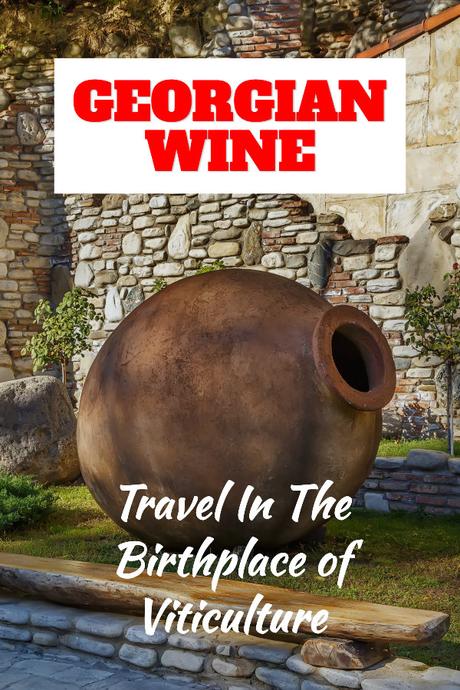In the last few years, Georgia has grown exponentially in popularity as a tourist destination. Despite the relatively difficult-to-reach location, smart travelers and tourists can discover the country's wealth of attractions, all at a tiny price. In Georgia, you'll find the spectacular Caucasus mountains for hiking, deep valleys for exploring, miles of Black Sea beaches, friendly people shaped by a turbulent history, and fascinating cities like the capital, Tbilisi.
But Georgia (or Sakartvelo as the locals call it) has something else. Something deeply rooted in the culture that attracts visitors to the country. That something is Georgian wine. Over 500 grape varieties are indigenous to this land, considered the birthplace of viticulture. If you like to travel and you enjoy wine, Georgia should be top of your list of travel destinations in 2022.
Food and drink are as much part of the travel experience as any trip to a national park, museum visit, or adventure excursion. As a wine-obsessed traveler, exploring the delicious red wine, white wine, and amber wine of the oldest wine-growing region in the world was like visiting the promised land. Please enjoy my Georgian wine guide for travel lovers.
Why Georgia Should Be On Your Foodie Radar
Despite the fact that there's evidence showing Georgia as the birthplace of viticulture, little is known in the west about the region. With thousands of grape varieties and a population seemingly obsessed with drinking wine (as well as eating dumplings and cheesy bread), there is much to discover here.
Often called "the cradle of wine", everything is different in Georgia. The wine tastes different, full of profound bouquets, mouthfeels, and palettes.
The wine powerhouses of France, Spain, Italy, and to some extent Argentina, Chile, USA, and Australia dominate world production. Meanwhile, Georgia, a tiny nation with a long history of viticulture, it trying to catch up after years of neglect.
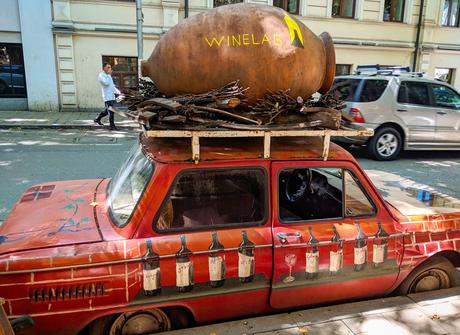
To this day, Georgian wines are still mostly exported to the former soviet-bloc countries. Being outside the EU (but wanting to be part of the economic bloc) Georgia does not have easy access to the biggest economic bloc in the world. But wine exporters are slowly breaking into new markets in Europe. And Europeans, Americans, and Chinese consumers, in particular, are growing fonder of this new wine from the old country.
While Georgian is definitely old-world wine, it's only just starting to make an impression on the world stage.
Georgian Culture Is Linked to Wine
There are 4000 languages in the world that make use of some form of a writing system. But there remains only a small number of unique writing scripts in the world. Georgian is one of them and many believe that many letters of the alphabet represent the curly shape of vines.

The Qvevri, a sort of bulbous vessel that looks a bit like a raindrop, is the vessel that made wine. Wine historians believe that the shape of the qvevri represents the womb. In any case, the qvevri is part of the country's Intangible Cultural Heritage, a UNESCO recognized representation or expression of a place's cultural heritage.
Regular Georgian people speak with authority on wines. Tbilisi's countless wine shops are staffed by highly knowledgeable and passionate people. Even supermarket wine managers can talk about wine in a way that would shame some specialty store owners in the west.
There are ancient rules around eating and drinking. Every feast must have what's called a Tamada, a type of toastmaster, who encourages everyone to drink after every rousing, motivational monologue.
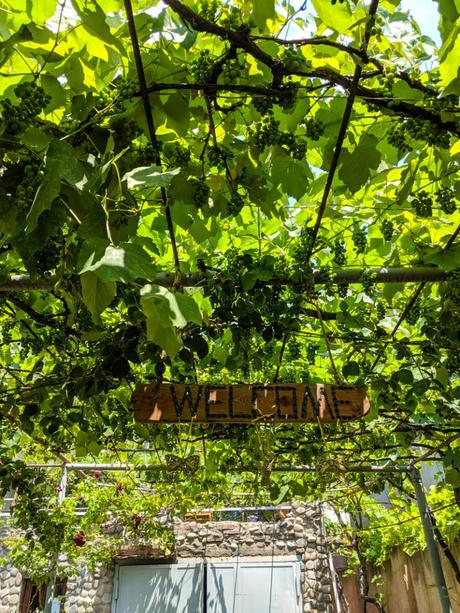
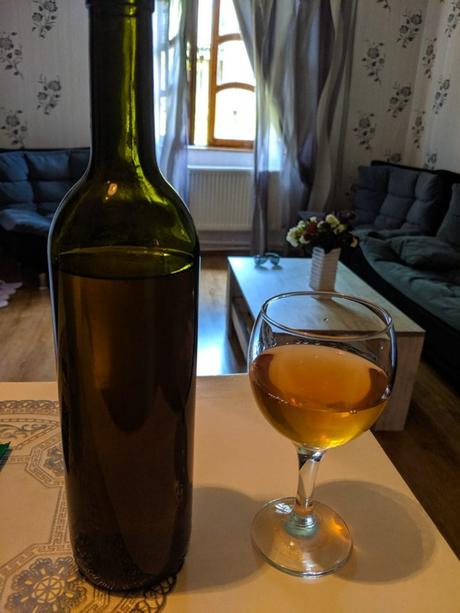
Wineries abound in the Georgian countryside, especially in the west. But the vast majority of wines are produced and consumed at home. Making your own wine in your own backyard, driveway, or balcony are typical ways of producing the beverage that accompanies everyday meals.
The history of wine is woven with the history of human civilization like a grapevine. The grape colonized the world but it all started in this tiny sliver of land that we now call Georgia.
Modern Georgian Wine History
Not all Georgian wine is made equal. In fact, only recently has quality wine production restarted on a large scale. The Soviets sent Georgian wine production into a downward spiral of blandness. Only wines suited to Russian tastes were permitted throughout Soviet rule and this almost killed the Georgian wine industry. It bounced back a little after the fall of the Soviet Union, but as Russia was the biggest market for wines produced in Georgia, the local wineries continued to produce low-quality, sweet wine.
Russia, which once controlled the country when both were part of the USSR, was the biggest importer of Georgian wine. But "quality" was never top of the list of attributes. Cheap, sweet plonk was the order of the day for decades. After the fall of the Soviet Union, when tensions between the two countries reached a peak, Georgia's massive neighbour banned imports of all bottles into Russia.
At first, it was a major blow to the economies of wine regions, but then it became the impulse for businesses to produce higher quality products and sell for higher prices.
As the story goes, the Georgians, known as proud and resilient people, spent little time contemplating the almost total destruction of their wine economy. They upped their game and began improving the quality of their products in order to appeal to more discerning buyers in Europe.
The strategy worked. The return to natural wines sparked the interest of certain markets in Europe. This was enough to replace Russian demand for cheap plonk. And Georgian wines regained their status as unique and interesting.
The landscape and the lack of investment in infrastructure and development were in a way responsible for helping keep the wines of this region. Grapevines that have never felt the presence of fertilizers and grape varieties that managed to hide from the Russians in the Caucasus mountains and other mountainous parts of Georgia (of which there are many) have survived pretty much intact. Unlike much of the rest of the world which has succumbed to mass production methods and ever more efficient (and damaging) ways of producing wine, Georgian wine still has much personality. It's kind of like that weird but interesting cousin you meet every now and again.

Qvevri Wines
A major difference between wine grown in Georgia and most other places is the use of the oval-bottomed clay vessels called the qvevri or kvevri. There's evidence of winemaking with these pots from 6000 BC.
Despite invasions by the Turks, Iranians, Russians, Mongols, and pretty much everyone else, the tradition has survived. It's no wonder vine growing, viticulture, and the qvevri are woven so deeply into the culture of the Georgian people.
Wines produced using the qvevri often have more complex flavours and are "heavier" than barrel fermented wines. If it's your first time trying this type of wine, it's worth looking for a "light" qvevri wine to taste or buy. Ask an expert. In Georgia, they are everywhere.

Note that some of these wines begin to taste better as you work your way down the bottle - this has nothing to do with the effect of inebriation. The heavier wines work really well with meats, especially red meat and spicy food.
Its worth remembering that Qvevri wines and natural wines make up a smaller part of overall production. These days, modern methods are also used extensively. But visitors to Georgia have better access to locally produced, small-batch wines. And in the case of natural wines, visitors can taste delicious, delicate and unique wines that are not suitable for shipping to other countries.
Returning to wine-making roots, producers began using clay vessels (qveveri) to ferment grapes - making sure that the grapes have skin contact with the liquid. This ancient way of fermenting was largely ignored during the years of mass-production for the Russian market. But now, it's one of the things that makes Georgian wine so special.
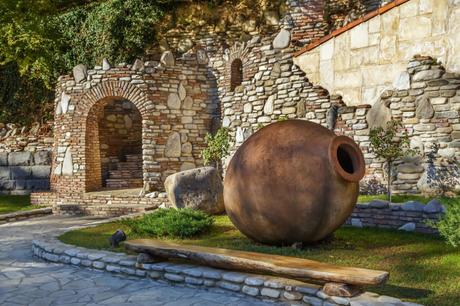
Natural Wines
Natural winemaking and qvevri wines are not the same. But there are many principles shared between the two processes.
Natural wine describes wine produced using organic processes. Think of it as wine produced with as little added as possible. Instead of adding sugar, cultured yeasts, sulphites, and other additives, the grapes are left to their own devices to ferment naturally and produce wines that are different from anything you've ever tasted before. The entire grape and sometimes stems and other bits are also used. The skin contact method of fermenting produces unique flavors. Ambar or "orange" white wines are sometimes referred to as skin-contact white wines.
The qvevri is a perfect vessel for producing natural wines due in part to the material used in constructing these terracotta pots.
Sulphite (sulfur dioxide) is added to almost every bottle of wine produced in the world. The stabilizing agent helps improve a wine's shelf life but minimizing oxidation. It has the effect of helping maintain consistency in wine vintages. While this sounds like a good thing, it's worth remembering that these food preservatives can be harmful.
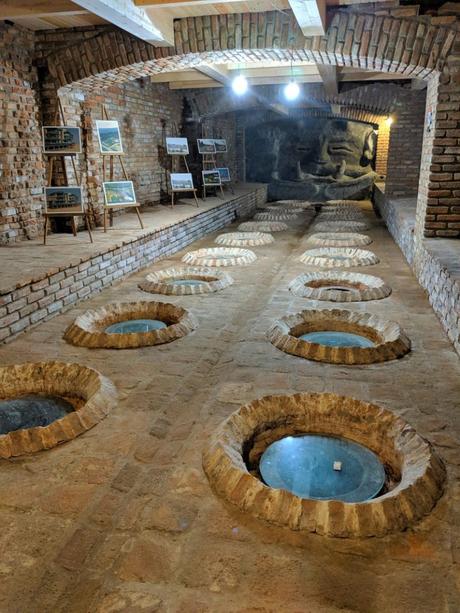
Wines are a product of grape fermentation. All the tasty stuff in life comes from fermentation: wine, beer, chocolate, and products that are good for your gut: kimchi, sauerkraut, kombucha. When we mess with this process, we mess with life itself.
But natural wines or low intervention wines (not 100% naturally produced) are difficult to produce en masse. And quality control can be difficult.
I spoke to a wine importer in my own country (where Georgian wines are rarely seen) who mentioned that they had a lot of problems with customers returning the bottles. "Smells like egg" or "weird first taste" were some of the complaints. He suggested to the customers that they waited a few hours or even a day for the wine to "air". That did the trick in many cases but other drinkers weren't impressed and asked for a refund. As a result, the importer stopped importing bottles not containing sulphur.
Another benefit of drinking natural, locally-produced stuff is that natural Georgian wine includes no yeasts, sulphites, and other substances that speed up fermentation, increase longevity, and generally smooth out the taste (read: make the wines bland so they are more sellable). But the lack of added junk means there's less chance of a killer hangover.
Types of Georgian wine - Know what to order
There are 20 appellations registered with Georgia's national intellectual property center. As of 2011, Georgian wines are protected in the EU zone to prevent imitations in the region. This helps countries benefit financially from intellectual property certified as having originated in a particular area.
The appellations are
You might have noticed the absence of Saperavi from this list. Unfortunately for the Georgian wine industry, the widespread use of the grape in other countries means that it has not been possible to claim intellectual property rights on this appellation. However, as recently as 2018, Khashmi Saperavi was added to the list.
SaperaviThe best-known variety and a grape native to this part of the world, Saperavi could be considered the flagship grape variety of Georgia.
A dry red, this is the first wine visitors should taste. Full of flavours with a complex aroma, Saperavi is popular with locals and tourists. You can find bottles of Saperavi everywhere.
The wonderfully-named Khvanchkara is a deliciously semi-sweet red wines from Western Georgia. Dark red in colour and aromatic, Khvanchara is a perfect introduction to Georgian wines with a little sweetness.

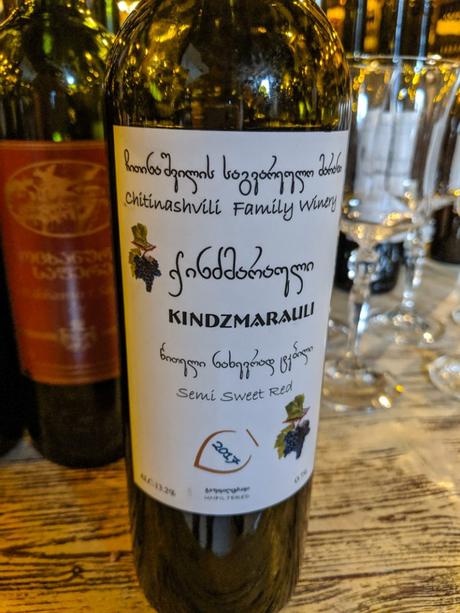
A dry white wine (or amber wine) that has citrus, fruity tones and is often fermented in qvevri. Mtsvane could be considered the signature white wine of Georgia.
The main white wine in Georgia, from Kakheti. According to Wine Searcher, the taste of Rkhatsiteli is refreshing, with crisp green-apple flavours and hints of quince and white peach. Comparable to Pinot Grigio.
Chateau Mukhrani and Chateau Khashmi wineries offer excellent Rkhatsiteli.
Kisi grapes, native to Kakheti, produce qvevri wines with aromas of smoked wood, and flowers. An amber wine considered one of the best in Georgia.
A semi-sweet wine with the flavour of cherry. This is one of the most popular of the semi-sweets.
Tbilisi wine shops & wine tasting
Tbilisi might not be the centre of the wine-growing region but it is the capital, the economic driver, and the place where many good wines end up. You'll find more wine shops, wine cellars, and garden vineyards here than anywhere else in the world.
If you like browsing around wine shops, tasting a few bottles, and chatting with people well versed in the world of enology and viticulture, Tbilisi is a great place to spend time.
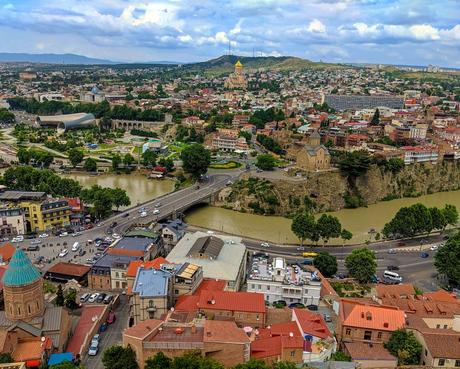
Wine shops with names like "wine library" and "8000 vintages" abound. The staff usually speak very good English and will talk at length about the products they sell.
There's no obligation to buy and it's easy to spend half a day sipping on wine without buying anything. Staggering to the nearest coffee shop is the usual next step. But I've yet to leave a wine tasting without buying a bottle. A feeling of guilt and the temptation to check out a new bottle is too strong to resist.
Wine Library
64 Irakli Abashidze Street, TbilisiWith knowledgeable and attentive staff, Wine Library in trendy Vake feels more like a friend's personal (albeit quite large) wine cellar. There's a large table near the back where people gather in the evenings to sample wines and converse. There are also tables by the windows where you can order snacks and a ridiculously good value wine to start (or end) your evening.
Open every day from 11 am to midnight.

8000 vintages
60 Irakli Abashidze StreetAn enormous wine shop on Abashidze Street, 8000 vintages is a place to get lost and admire the thousands of bottles on display. It's also the perfect spot to sample some unusual wines and buy a bottle that you might not find without going to the source.
The name comes from the number of vintages estimated to have existed since wine was first cultivated in Georgia some 8000 years ago.
That's plenty of time to perfect the craft of winemaking and this store will introduce you to some of the best that the country has produced. There are more wine varieties here than you will ever have time to sample. But don't let that stop you!
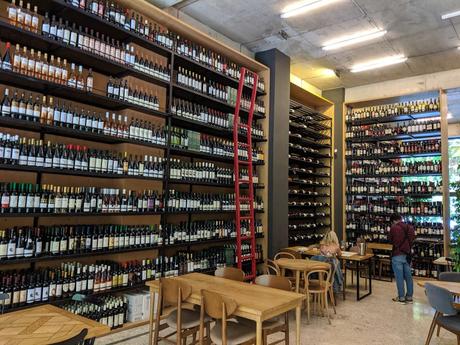
The business has three locations in Tbilisi but the one in Vake is mere metres from Wine Library so you can simply walk (or stagger) between the two.
Wine is placed on shelves according to variety and origin, rather than letting price or individual wineries influence placement.
The other locations:
26 Sulkhan Tsintsadze St
27 Revaz Tabukashvili St (near the Opera and Ballet Theatre)
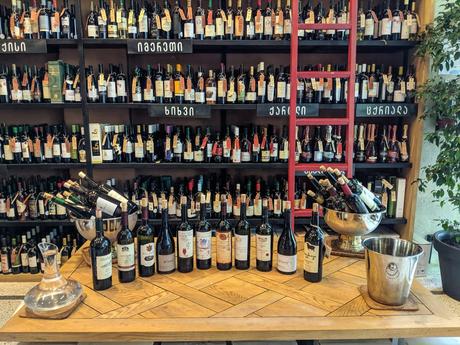
Wine Gallery
Corner of Tsinamdzghvrishvili and Nadiradze streets (east side of the river).A pleasant place to browse and sample wines from all over the country. This store wins a prize for the most interesting entrance and exterior. Wine Gallery has two floors; the ground level floor, a showcase of bottled wine, and the basement, a gorgeous wine cellar with red wine and white wine on tap.

The staff is quite happy to discuss in depth the merits of each type of wine as long as the place isn't too busy. And it does get busy so pick your times to visit.
You can also try different brands of chacha, Georgia's notoriously strong pomace brandy, in the store.
The best wine store in Tbilisi.
Open every day 10:00 - 21:00
DADI Wine Bar & Shop
Shalva Dadiani, 4, TbilisiMore a place to meet, greet and drink wine over food than a place to browse bottles and sip samples. DADI, located in the historic center of Tbilisi, is a super popular bar serving natural wines from the best Georgian makers.
Grab some cheese (always good with the grape), paté or smoked meats and ask for wine recommendations from the helpful and knowledgable staff.
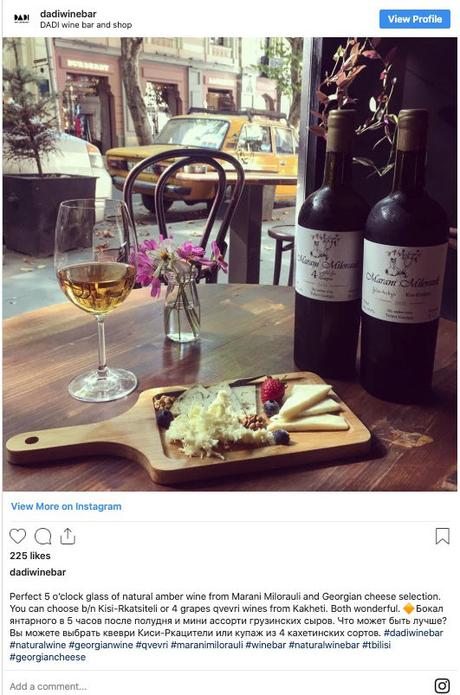
Reserve Wine Tasting Shop
3, 9 Aprili St, TbilisiA modern tasting shop with marble tabletops and an all-glass exterior, this little gem behind the Georgian parliament building stocks delicious wines at affordable prices.
The cool-aired wine cellar is a nice place to avoid the heat of the summer and browse some of the best bottles the city has to offer.
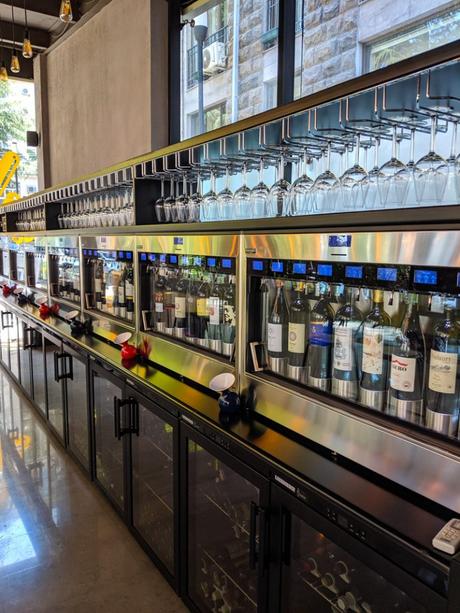
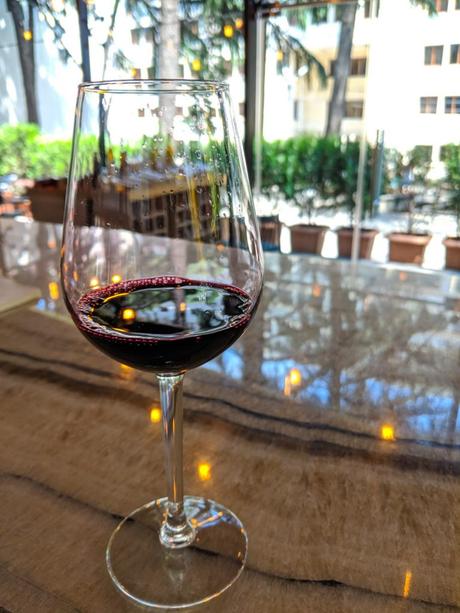
Tasting works a little differently here. Order your wines and pay a fee per glass. While that sounds like any other bar, the difference is that you can sample higher-end bottles and varieties you won't find anywhere else, at least not by the glassful. The prices are reasonable. Reserve is a good spot to start your evening.
Chat to the staff who, in my experience, are willing to discuss all aspects of winemaking in Georgia. Grab a seat by the tall tables in the air-conditioned main room or take your glass outside and sit by the green garden overlooking the enormous granite buildings of parliament and central banks.
Try the excellent Dakishvili family selection dry red Saperavi, fermented in qvevri and aged in Limousin oak for 12 months. A delicious red wine variety to try.
If you like something a little sweeter, the Akhasheni semi-sweet red wine is a 100% natural product with no added sugar and berry tones. It's also certified Bioorganic.

Open every day (from around noon) until 10 pm
Wine Tours From Tbilisi
The capital is the main starting point for all things related to Georgian wine tours. Book your tour on the ground or try one of the recommended tours below.
Living Roots food & wine tours - Taste one of the world's oldest and richest food cultures
Georgian Wineries And Wine Tasting
There are countless wine producers in almost all parts of the country. The majority are concentrated in the Kakheti region but other regions play significant parts in the wine economy. For visitors to Georgia with limited time, the following wineries offer some of the best value.
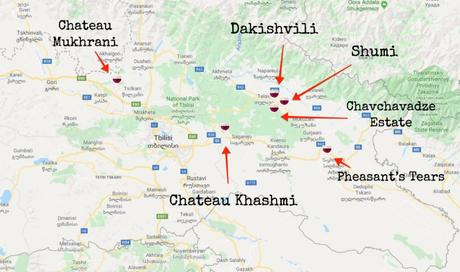
Pheasant's Tears, Sighnaghi
The best-known winery outside of Georgia was started by an American. Based in Sighnaghi in the west of the country, Pheasant's Tears is a popular spot for tourists. The winery appears in almost every wine book written in the last 10 years and this has generated a lot of interest. The on-site restaurant and wine tasting help satisfy the demands of visiting wine enthusiasts.
All wines are fermented and aged in qvevri (no oak barrel flavours) and the wine cellar was constructed in the vineyard to avoid degradation of the grapes in transit.
In my native Ireland, a country that has truly embraced wine in the last few years, Pheasant's Tears is one of the small number of bottles available.
Chavchavadze Estate, Tsinandali
Tsinandali Estate is a beautiful and historic piece of wine-growing land near Telavi.
The former home and museum to one of Georgia's most important people Alexander Chavchavadze, sits at the entrance to the estate. Chavchavadze is recognised as the father of modern Georgian wine.
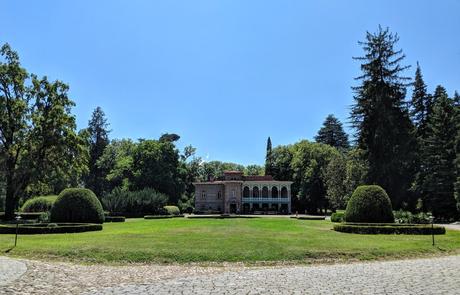
The Tsinandali Festival is a musical event in September set in a covered amphitheatre in the grounds of the estate.
A recent addition (2018) to the estate is the Bond movie-Esque Raddison Collection Hotel hidden away behind the Alexander Chavchavadze Museum house and winery.
11 varieties of Georgian vines are cultivated here. Saperavi (the best-known vine), Mtsvane (a favourite of mine), Kisi, Rkatsiteli, Khikhvi, Usakhelouri, Alexandrouli, Mujuretuli, Tsolikouri (Western Georgia), Tetra and Ojaleshi.
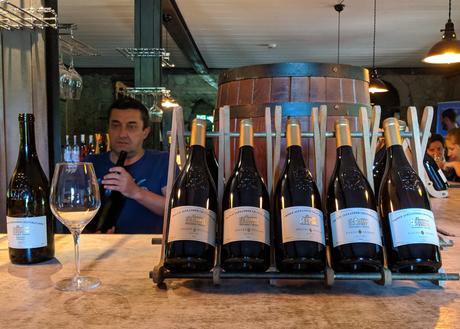
Shumi Winery
Shumi means undiluted in Georgian. The production of wine at Shumi is full cycle, meaning the winery takes care of the growing, harvesting, fermenting and bottling of wines. 90% of the wines are exported, mostly to Europe. Some bottles can only be consumed in the country (or taken out in small numbers)

Wine Enthusiast gives Shumi's 2014 Saperavi a score of 89 out of 100.
Chateau Mukhrani Winery
A good choice for a quick boozy visit from Tbilisi, Chateau Mukhrani is only 30 minutes from the capital. Wine was first bottled here in 1878 and they've named the restaurant Royal Cellar 1878 in honour of that date.
Mukhrani wines are matured for up to 18 months in oak caskets which, according to the Mukhrani website, gives extra "harmony" to the finished product. You'll have to try for yourself to discover what extra elements wines from this part of the country display.
Wines offered include the deliciously crisp Mtsvane and Rkatsiteli, both indigenous white grape varieties (Mtsvane grapes & Rkatsiteli, grapes are often blended together). Local dry reds include Shavkapito and Saperavi. Semi-sweet wines include Kindzmarauli and Khvanchkara.
The former capital of Georgia, Mtskhta is on the route from Tbilisi to the Mukhrani winery and is definitely worth a look. Visiting both places is a wise choice for a relaxed but cultured day trip.
Contact the winery about tours, lunch, and wine & food pairing events. All are well worth doing.
If you can't make it out of Tbilisi, the business has a small wine studio in the old district of the city where you can taste wines from the vineyard as well as tasty Georgian cheese.
Dakishvili
Located in the eastern part of Kakheti, the country's most fertile vine-growing region, Dakishvili winery is a specialist in Saperevi, Kisi and Rkatsiteli varieties.
Wines are bottled on the estate and come from the Dakisvili vineyards located in a unique microclimate (as so many of the wineries in Georgia are) with excellent alluvial soil for viticulture.
Wine tasting and tours are only available by appointment so make your reservation before you drive the 2-3 hour journey from Tbilisi. The wine cellar and grounds are beautiful places where you can feel the passion of winemakers in love with their craft.
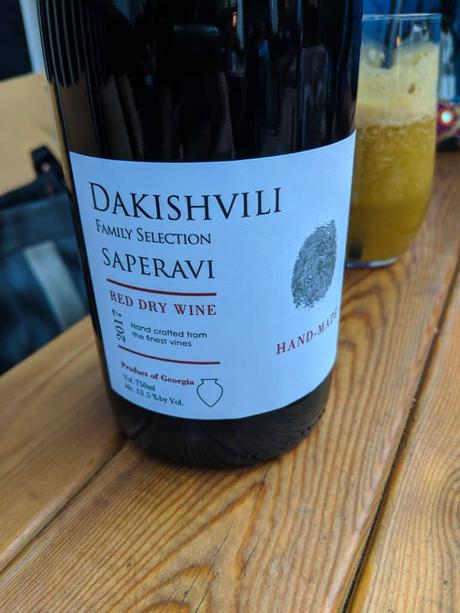
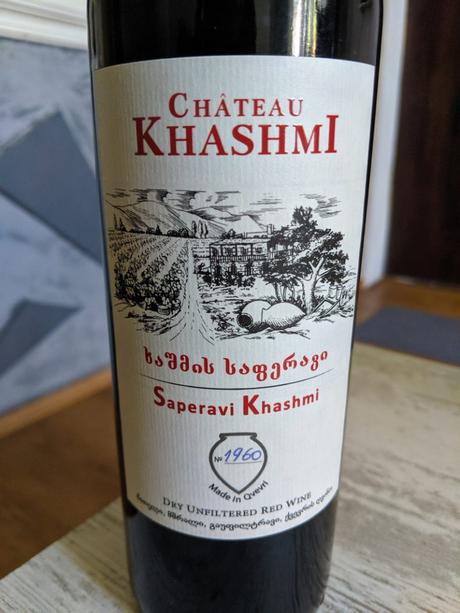
Chateau Khashmi
Chateau Khashmi, another winery located close to Tbilisi, produces wines of the highest quality. Khashmi's Saperavi, a protected appellation, is a dry, unfiltered red wine made in Qvevri with spontaneous fermentation processes (nothing added). It's as close to raw wine as you can get. An intense flavour with dark fruit tones and hints of smoke. This is a wine to savour.
Considered one of the best places for Saperavi, the village of Khashmi is now a Protected Destination of Origin.
The Rkatsiteli is a dry, unfiltered amber wine. Chateau Khashmi's qvevri amber wine is natural and delicious.
Get the full winery experience by staying in the Hotel Chateau Khashmi.
Finding Fans Around The World
According to The National Wine Agency of Georgia, in 2021, Georgian UK wine exports soared 60%. A new service called Georgian Wine Connect offers virtual wine tastings and a platform for wine buyers to meet wine producers
At the Qvevri Georgian Wine Festival in London in November 2019, Danilo Di Salvo, owner of Gvino UK, one of the leading London-based importers of Georgian Wines, talked passionately about his business and the future of Georgian wine. I asked Danilo why he thought why he believed Georgian wines are seeing a resurgence in popularity.
As wine drinkers search for different wines with interesting stories, Georgian varieties are gaining traction. The still-unknown grape varieties and history are hugely appealing to new and old wine drinkers. Furthermore, we are seeing much more about Georgia as a tourist destination and visitors rave about the fabulous food, drink, and culture. All these ingredients are combining to increase the popularity of the local wine.
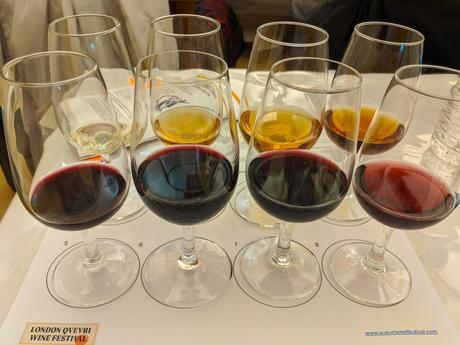
We select our wines by tasting them! Before launching the business, we toured around many vineyards and tested many products. We were searching for good quality and consistent wines, and high-quality, clean and well-managed vineyards. We selected a handful of vineyards and tasted a selection of their wines with a team of oenologists.
We are passionate about ensuring that our vineyards stay healthy both botanically and financially because they employ many people from the surrounding area.
When we had narrowed ourselves down to a small number of vineyards, we asked ourselves "what would UK wine drinkers want to drink? How would the UK feel about Georgian Qvevri amber wine?"
We are still learning. We love to get feedback from customers about what they prefer, and we're happy to say that we've pretty much got it spot on. We often hold small and intimate tastings with friends in the UK for our new wines before we order as the final test.
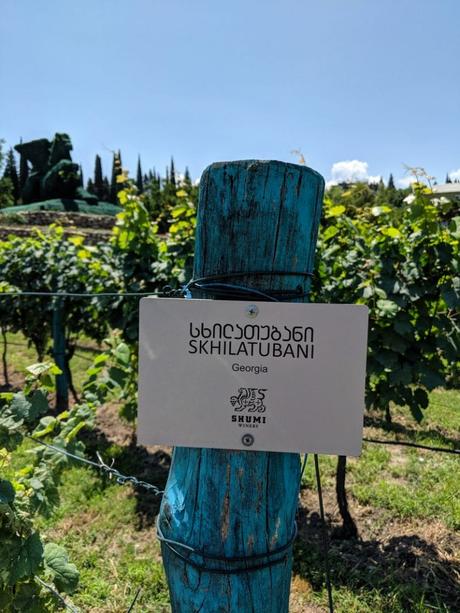
It's still a growing market but the most popular Georgian wines are those that people can relate to. The Saperavi red grape, which is highly versatile, can be made into wines that appeal to the palate. Wines produced with European winemaking processes, for example, Our Georgian Sun Saperavi Aleksandrouli, appeals to consumers who have never tried Georgian wine.
However, we have seen a great rise in sales of Qvevri wine, especially amber or orange wines (such as our Qvevri Mtsvane). It's certainly fair to say that these wines are completely different from almost all other wines from around the world. We love to see the look on people's faces when they try Georgian Qvevri amber wine for the first time! It's such a different experience.
Books About Georgian Wine
There isn't a huge choice in books about Georgian wine - even the recently published 8 th edition of The World Atlas of Wine, brilliant as it is, only devotes 2 pages in a 416-page book to the wines of Georgia.
But how and ever, these are the best books to read to broaden your knowledge.
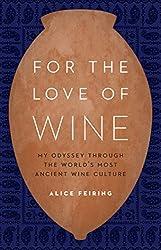

Alice Feiring
Alice Feiring's personal account of her time in Georgia sampling wines and attempting to sabotage the advances of the western world on Georgian winemaking. Feiring is passionate about wines produced naturally, as it was for millennia. She meets winemakers on both sides of the fence (natural and non-natural) and also people trying to convince the Georgians to switch to chemicals and modern methods of producing more wine. But at what cost?
The Soviets demanded huge quantities of Georgian wine during the occupation. But they cared little about quality. And the entire industry became focused on mass-produced, single-variety wines to suit the Soviet tastes. Natural wines were banned (from production) and quality dropped significantly.
This is something that Feiring seems to want to put straight. Her enthusiasm for wines grown organically is contagious. This account is more about the people involved in the modern wave of winemaking than any particular variety, blend, or winery.
Georgia: A Guide to the Cradle of Wine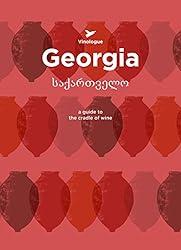

Miquel Hudin and Daria Kholodilina
A fascinating look at not only wine but the culture and food of this incredibly interesting country.
A complete guide to everything oenology.
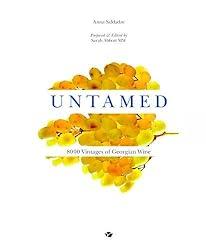

Anna Saldadze
This book is a voyage of discovery into the deep history of Georgian wine and the culture that has kept the ancient tradition of viticulture alive during a turbulent past. Saladze shows just how closely aligned the people of this country are with the vines that grow so well here.
A beautiful book of illustrations, maps, prints, and eloquent prose.
Tasting Georgia: A Food and Wine Journey in the Caucasus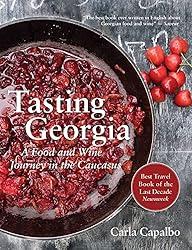

Carla Capalbo
After all that drinking, you're going to get a bit peckish. Luckily Georgian food satisfies even the most demanding of foodies. This book looks at the food and wine of Georgia in equal measures. Prepare to feel hungry.
